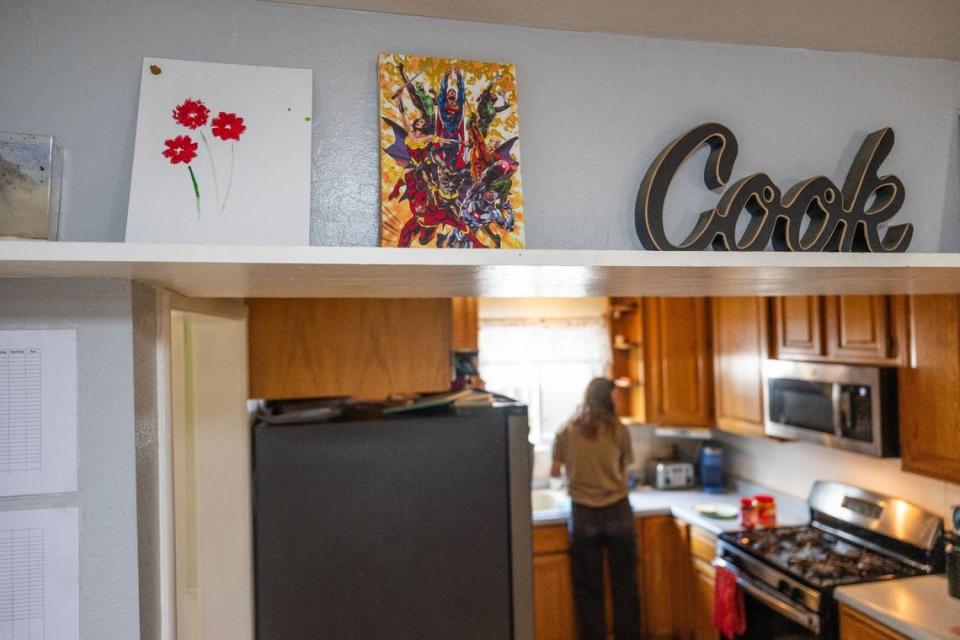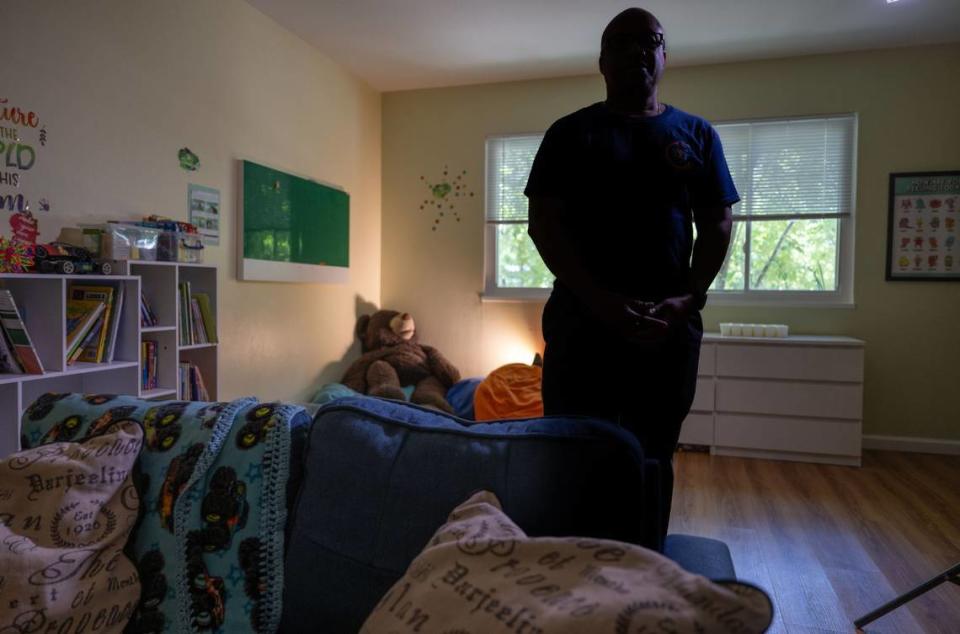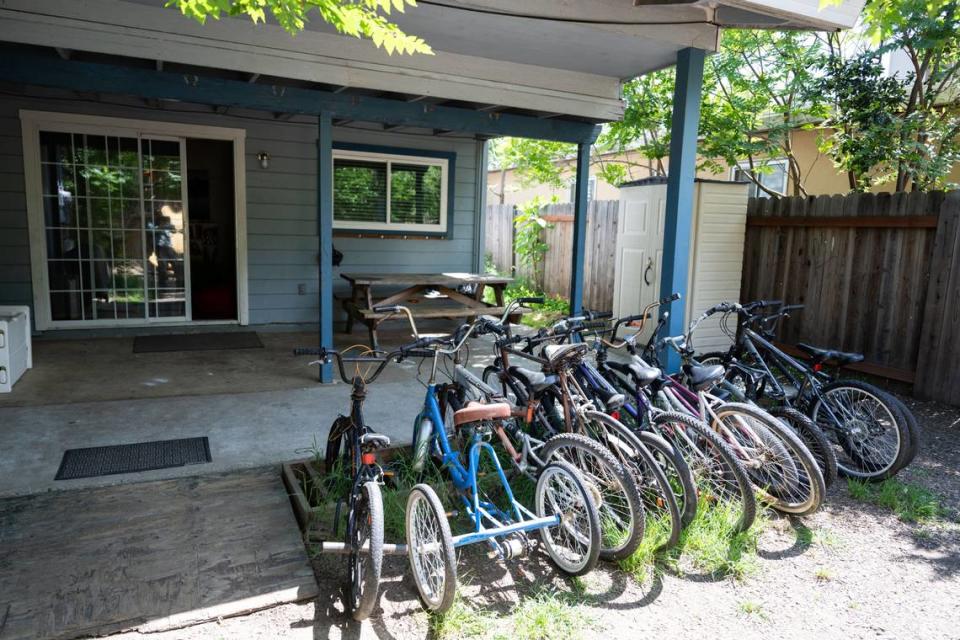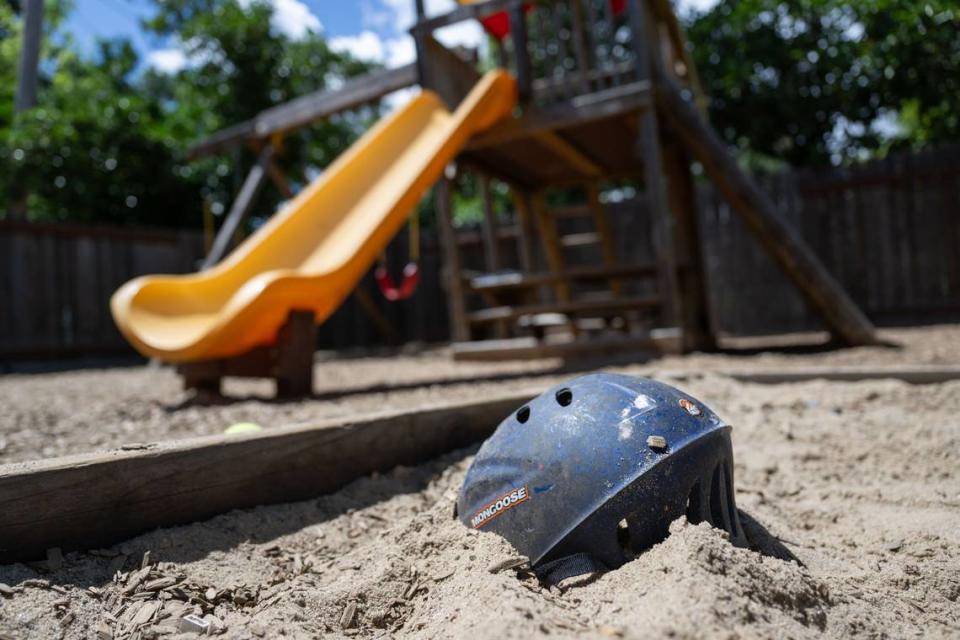Foster kids already face trauma and stigma. Would a new California bill add to it? | Opinion
- Oops!Something went wrong.Please try again later.
- Oops!Something went wrong.Please try again later.
The house is as ordinary as possible.
In each of the three bedrooms, including the master, there are two beds. Handmade quilts, neatly tucked, bear the embroidered name of the little boy who sleeps under it each night. He’ll get to take it with him when he leaves. A Lab-mix puppy named Dahlia pounces on bugs in the backyard. Well-loved bicycles of various sizes are stacked neatly in a rack, while helmets are strewn wherever they fell on the lawn.
On one wall in the dining room, the boys’ chores are labeled neatly with their initials. A list of dietary restrictions is stuck to the fridge.
On another wall are six laminated pages, one for each of the boys. It’s a list of emergency contacts, times and dosages of their medications, their current grade and school, mental health struggles, triggers and possible interventions, and precise details of their next parental visit.
Opinion
As ordinary as it looks from the outside, this suburban home near Downtown Davis is one of California’s short-term residential therapeutic programs (STRTPs) operated by the non-profit public benefit agency Progress Ranch. Homes like this are the state’s latest answer to providing for foster children whose severe behavioral issues require specialized and intensive care, supervision, services and treatment.
The adults here are trying to provide an ordinary home environment, but the children who live here have experienced incredible trauma. They often act out the only way they know how — with rage and violence. Sometimes, their abuse can only be stopped by an adult physically or medically restraining them.
Loving these children is simply not enough.
It’s a difficult subject because it’s also a situation ripe for exploitation: Even a well-meaning restraint could swiftly or unintentionally veer into physical abuse, which makes regulating these homes a challenge for California legislators. Three women in the legislature, a Republican and two Democrats, including one from Sacramento, are trying to address the situation with a new bill this year. But they face hard questions.
How can California regulate the practice of restraint to keep these children and caregivers safe? How can we ensure there is no further trauma inflicted on these vulnerable children and not exacerbate the stigma of being a foster child, much less one with serious mental health needs?
The bill proposes to bring more transparency to all uses of restraint at STRTPs, but I don’t know if that’s the right approach.
I do know this, though: Everyone involved wants to protect these children from further abuse, and that’s the right place to start.
Workers suffer daily abuse
STRTPs were established in California in 2015, and children in these homes are often wards of the state. At Progress Ranch, they are boys ranging in age from six to 15, but the team in Davis is careful to keep the pendulum of ages to one side or the other — never allowing teens to live with small children.
The ultimate goal, said Executive Director Alyssum Maguire, is to help these children learn healthy coping mechanisms for the multitude of traumas they have experienced — often the reason for them ending up in the foster care system in the first place. Then, they can be placed with foster families, and perhaps someday adopted.
Maguire said they try to recreate a family environment so that when the boys are ready to be placed in a home, it’s not an unfamiliar situation, which can be re-traumatizing to them. “We’re really trying to break the pipeline to prison and homelessness,” she said.
So, the house is as ordinary as possible.

California used to send foster children with serious behavioral issues to rehabilitation programs in other states. Three years ago, Gov. Gavin Newsom and the state legislature approved $8 million to bring those children home and into the STRTP system, which is already overburdened and underfunded.
Foster children in California are disproportionately children of color, and accustomed to living in poverty or dangerous situations. That tends to be why violence is the only language they have for dealing with their anger, frustration or sadness.
According to a report from the Legislative Analyst’s Office in 2023, “the proportions of Black and Native American youth in foster care are around four times larger than the proportions of Black and Native American youth in California overall.” Researchers estimate that, nationally, approximately 85% of families in the child welfare system live with incomes below 200% of the federal poverty level.
“They’re fully capable of going into a family and becoming a really wonderful adult and to continue being a really wonderful child,” Maguire said. “I don’t think that it’s fair to look at them through the lens of their worst, most vulnerable moment. Just because a child needs residential treatment for their mental health issues doesn’t mean that they’re this super dangerous, bad kid all the time.
“They’re a child, and they need a lot of support right now.”
Ian Longue, an employee of Progress Ranch for nearly 20 years, told me the story of a little boy who dearly loved one of the staff members, but just couldn’t connect with his social worker. One day, the staff worker came to work dressed for court, and the child snubbed her for weeks afterward. Careful conversations with the boy revealed that he negatively associated skirts and perfume with his mother, who had been a sex worker. Once the social worker stopped wearing perfume, the little boy could open up and receive the help he needed to be placed in a home.

While that situation ended positively, everyday interactions between staff and traumatized children can often be both physically and emotionally challenging.
Longue also recounted stories of being physically abused by children on a near-regular basis, with holes punched in walls and curtains, picture frames and even Hot Wheels used as makeshift weapons. There was one particularly creative boy who climbed up on the roof of the home and urinated on Longue’s head.
“Our staff get a lot of physical assault,” Maguire said. “This is intense, minute-by-minute work we do here to get them to a family. Sometimes we are saving their life.”
Bill requires public transparency
This year’s Senate Bill 1043 is co-authored by Sen. Shannon Grove, R-Bakersfield, Sen. Angelique Ashby, D-Sacramento, and Sen. Aisha Wahab, D-Hayward. Grove’s office said the bill was conceived when the senator sought information about the use of restraints from the Department of Child Support Services, which collects this data. She was informed there was no public database for her to see.
SB 1043 would require the parent or guardian of the child to be informed about any use of restraint or seclusion, which is something Progress Ranch already does, Maguire said.
But first: Leave your presumptions at the door.

A restraint is, typically, any restriction of movement for an out-of-control child, either by holding them back to prevent them from hurting themselves or someone else, or by administering prescribed medications for the same purpose. What it is not is a choke hold, a straight jacket or handcuffs (though sometimes arm and leg restraints could be used for a particularly violent and large child).
If we’re being honest with ourselves, I think most parents and caregivers would admit to employing a similar tactic for a physically-reactive child: Sometimes, you just have to stop the kid from lashing out with your own hands. That’s not abuse, nor is it about discipline; it’s a safety measure.
When such instances occur — and Maguire said it’s generally rare, but it depends on the child — a “restraint” can also simply be picking up and removing the child from the room or having an adult hold or block a child’s arms or legs from contact with others, including other children. Sometimes it looks like safe containment techniques, including separation into another room until the child can calm down.
California law is attempting to better define appropriate restraint methods and when they can be used. The practice can’t (and shouldn’t) be banned altogether, but neither can we allow for any abuse of the system.
And therein lies the conundrum: There is absolutely room for abuse within the system, and it would be foolhardy to say it never happens. But is a public database listing the worst moments of these children’s lives the right way to present this data? Especially when it’s already legally mandated to report all such incidents to state agencies?
“It is something that I worry about,” Ashby told me. “There’s a balance to be found between what we’re asking of these organizations and how difficult the (children’s) needs are ... and how we overlay that with communication and information to the public.”
The proposed database wouldn’t name the children, Ashby said, but it would name the home where the restraint happened. “It would be very difficult to (identify) who was restrained, but it would tell people who are dealing with the most difficult kids,” she said.
There is also the concern of adding yet another layer of regulation on top of an already highly-regulated system. Progress Ranch recently had to shut down one of its locations because it was too costly and difficult to manage the multitude of laws that vary from county to county. The closure resulted in the elimination of six beds for boys from a system that’s already struggling. A point-in-time study done in early 2024 found there were 1,436 kids in STRTPs throughout the state, and there are many, many more still waiting for placement.
“We don’t want to make it so difficult to do this work that no one does it, because we will have a population of people we can’t serve,” Ashby said.
It’s complicated
It’s not that SB 1043 could become a bad law. It’s that children this proposed law seeks to protect face specific challenges based on specific living conditions.
So when you get someone like Paris Hilton, a celebrity socialite and a genuine survivor of the “Troubled Teen Industry,” attaching her name and celebrity to legislation, the nuances can get lost in the limelight.
When Hilton came to the California Capitol last month to testify on behalf of SB 1043, she shared her horror stories of time spent in group homes more than 20 years ago.
“This would have been so helpful to myself and so many others to have known what was happening behind closed doors,” Hilton said in an interview with the Associated Press. “Because I was cut off from the outside world, I couldn’t tell my family anything, and that’s what they do.”
Hilton’s testimony painted all STRTPs that use restraints as something evil. Suddenly, Progress Ranch had news cameras outside their door asking why they tied up the little boys inside. But Hilton’s celebrity advocacy, however well-intended, is blinding the truth and subtleties of the issue.

More regulation isn’t always the answer, and putting these foster children’s worst moments into a database that will live on the internet forever could eventually be considered an invasion of their privacy, even if it’s just the homes that are named in the list.
After talking to Ashby, I see the sincerity of intent behind the bill. But after visiting Progress Ranch, I see how they’re trying to help these children, often minute by minute. I can’t help but wonder if it will be helpful to put more regulations on workers already struggling to provide a stable home for these children. We need more of these homes, not less.
Editor’s note: A previous version of this column misspelled the last name of Progress Ranch’s Executive Director, Alyssum Maguire.

